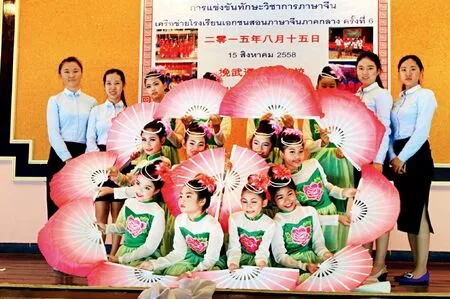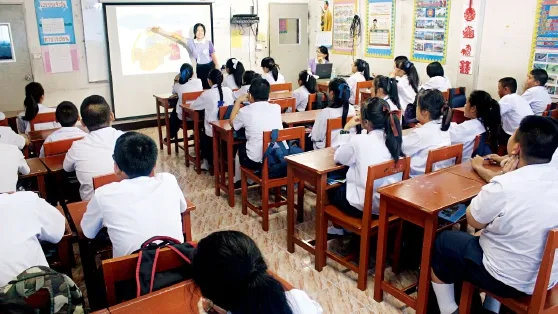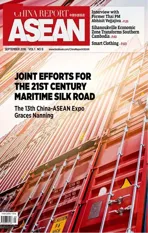Teaching Chinese in Thailand
2016-11-23ByLiYing
By Li Ying
Teaching Chinese in Thailand
By Li Ying

Li Ying presents a dancing performance with her partners and her Thai students.
Upon returning home after two semesters as a volunteer Chinese language teacher at a Confucius Institute in Thailand, my friends and relatives were quick to ask: What was it like to teach Chinese in Tailand? I immediately replied that I was impressed with the enthusiasm of Thai students learning the Chinese language. I would also say that I am thrilled that I was able to experience such a beautiful place and its wonderful culture.
Such was my time spent as a Chinese language teacher at Bansomdejchaopraya Rajabhat University in Bangkok, Thailand's capital, from May 2015 to May 2016.
Teaching Language and Introducing a Culture
Members of the Thai Royal Family are committed to exchanges between Thailand and China, and many have been personally involved in the cause of Chinese-Tai cultural exchange in recent years. Tis has led to positive relations between Tai and Chinese people.
My students in Tailand represented all age groups, from pre-schoolers to adult students. I felt both proud and a deep sense of responsibility in teaching them. The diversity in age groups required me to prepare a number of different lesson plans suited to different types of students.
The classes for kindergarteners were by far the most demanding. To make them interested and keepthem focused, I used games, songs and dance in my lessons. Learning through play helped the young students learn Chinese vocabulary extremely quickly. Tey were proud of their progress, which further piqued their interest in learning the Chinese language. Even afer class had ended,kindergarten-age students would also ask me questions related to Chinese words and expressions.
Before we began work as teachers at this institution, each of us underwent teaching Chinese as a second language training. It was during the training period that I learned that more than half of initial consonants in Chinese (14 of 23) have the same or similar pronunciation in Thai. Therefore, at the beginning of instruction, we would teach consonants similar in each language before moving on to the more difficult, different ones. Through repeated practice, students would gradually become more comfortable with Chinese pronunciation.
As their vocabulary grew, my students became more and more eager to learn about Chinese culture. The Confucius Institute offered a variety of courses on various aspects of Chinese culture, including folk songs and dances, tea ceremony, paper cutting, ink painting, calligraphy,the game Go and traditional operas. During traditional Chinese festivals,particularly Chinese New Year, the Institute faculty gathered with students to make dumplings, which both fascinated the Tai students and made the Chinese teachers feel just a little bit homesick.
The intricacies of the Chinese language and the richness of Chinese culture mesmerized my students. Many expressed a desire to travel to China someday. Some have realized this dream by studying in China, and many of my former students have received scholarships from the Chinese government, which they received in part due to their high scores on the HSK, the Chinese language proficiency exam. On Teacher's Day, my students wrote “Teacher Li, we love you!” on the classroom's chalkboard. I was moved to tears.

Li Ying giving a lecture about China to her Thai students.
Learning through play helped the young students learn Chinese vocabulary extremely quickly. They were proud of their progress,which further piqued their interest in learning the Chinese language.
Extra-Curricular Activities
The Confucius Institute brings Chinese volunteers and Thai students together, which provides a bridge between Chinese and Thai culture. In addition to teaching, I worked in the institute's library, wrote news releases,took photos, shot and edited video and maintained the school's website. I was also an editor for the culture section of Tong Hua, a leading Chinese language daily newspaper in Thailand. I also spent time as an HSK exam proctor and produced a photo exhibition honoring the 70th anniversary of the Chinese victory over Japanese invasion in 1945.
The Confucius Institute ran a highly efficient press release system. All news, no matter how late it came in, would be released within 24 hours. It was not rare for me or my colleagues to stay up until midnight working on a story.
One day, while heading a delegation to visit Tianjin, our institute's president called me just afer 11 p.m. to give me an urgent assignment. I jumped on my computer, downloaded related text and photos and began working on the story. Fighting drowsiness, I wrote and edited content related to the delegation's visit,proud of my hard work and happy to do my part in publishing the content to the school's website.
In my role as a librarian, I kept the institute's 5,000 books in neat order with the help of my colleagues. With instruction from professional photographers and the support of the institute's president, I became the“chief photographer” on campus.
After finishing my two semesters of service as a teacher at Bansomdejchaopraya Rajabhat University and returning to China, I have reviewed the photos I took several times. Looking at the pictures gives me a sense of pride and fulfillment. During the year I spent volunteering in Tailand, I was a witness and contributor to deepening friendship between the Tai and Chinese people.
